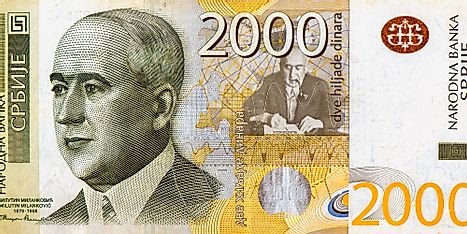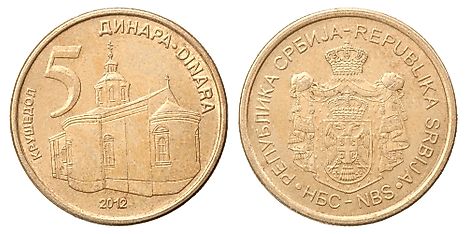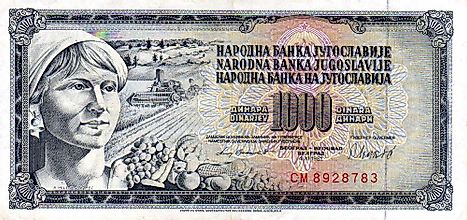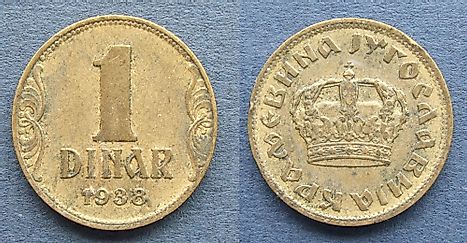Flags, Symbols & Currency of Serbia
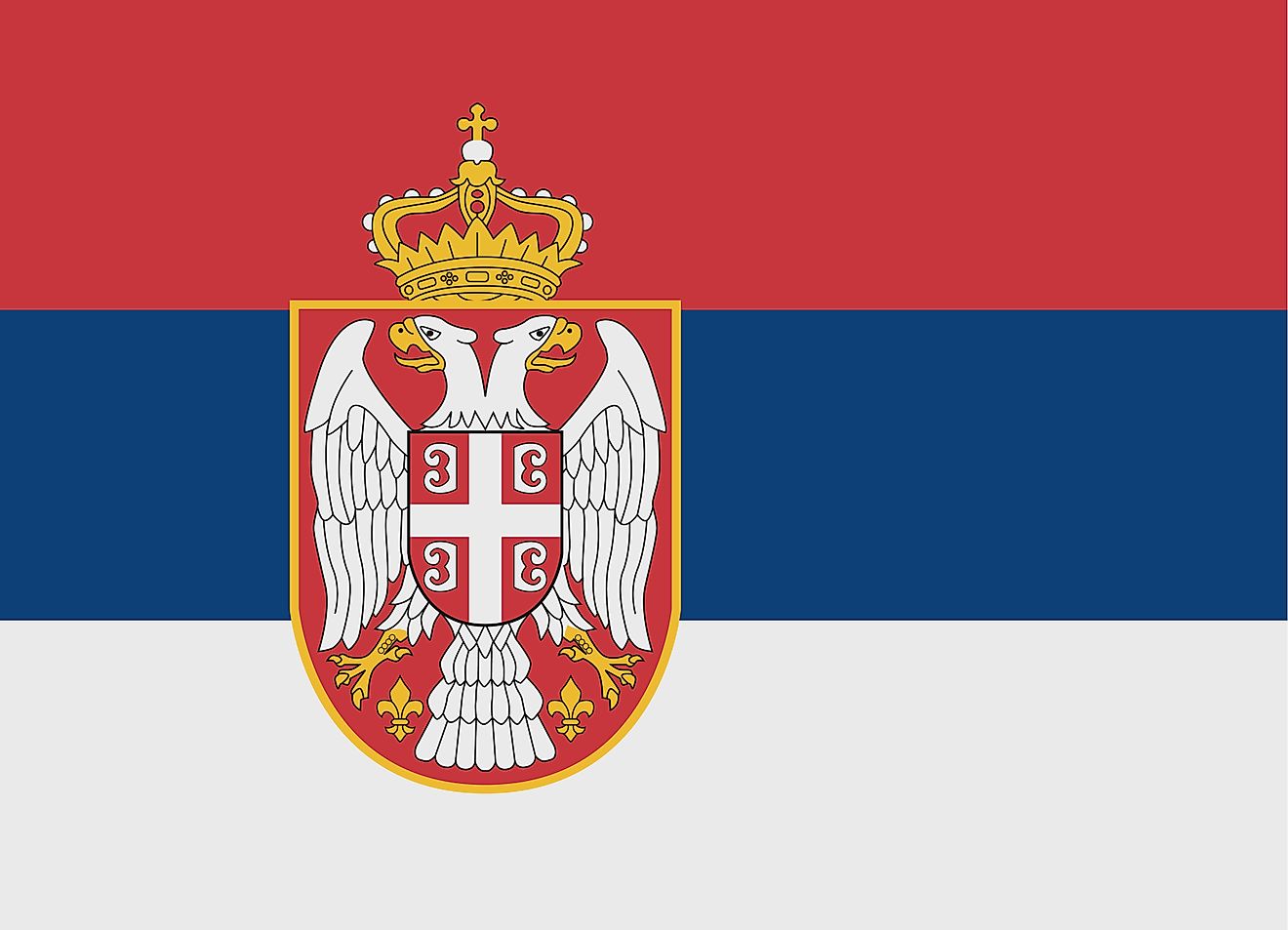
The National Flag of Serbia was officially adopted on November 11, 2010.
The National Anthem of Serbia features three equal horizontal stripes of the traditional Pan-Slavic colors - red (top), blue, and white. The coat of arms of Serbia is placed towards the hoist side of the flag. The Pan-Slavic colors of the flag represent the revolutionary ideas of sovereignty. The red color signifies the bloodshed during the struggle for freedom. The blue color denotes the clear sky, and the white color signifies dazzling bright light. The flag has a width-to-length ratio of 2:3.
History of the flag of Serbia
The history of Serbia’s flag dates back to the revolt against the Ottoman rule in 1804 when delegates from Serbia sought help from Russia. Russia offered help on the condition that Serbia’s delegation would participate in a parade during the revolt. At the time, Serbia did not have a flag to identify the country and its army during the parade but adopted a Russian flag turned upside down. The Ottoman Sultan recognized the Serbian flag officially in 1835. After gaining independence in 1878, the country established a state flag consisting of the red-blue-white tricolor with the Serbian coat of arms.
After WWI, Serbia became part of the Kingdom of Serbs, Croats, and Slovenes, and thus had no official flag. It adopted the Yugoslavian flag, which was a blue-white-red tricolor. In 1947, after WWII, the Federation of Serbia adopted a red-blue-white tricolor flag with a yellow-bordered red communist star in the middle. In 1992, a new flag without the star was adopted after Yugoslavia became an independent state. In 2006, after Montenegro seceded from the federation, Serbia adopted a new flag that was used until 2009, when new flag laws regulating the use of state emblems were introduced. A new flag bearing a visual redesign of the coat of arms was adopted in 2010 as the state flag.
Symbols of Serbia
The National Coat of Arms of Serbia
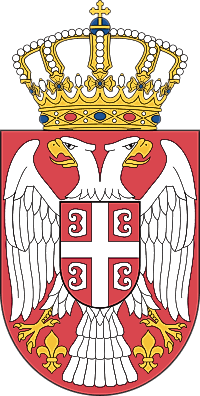
The National Coat of Arms of Serbia includes a principal shield and a smaller red shield. The principal field of the coat of arms represents the Serbian state. It also displays a two-headed white eagle and fleur-de-lis next to each talon, both of which are considered historic dynastic symbols. The smaller red shield in front of the eagle represents the nation of Serbia and is divided into four equal quarters by a white cross, with a Cyrillic ‘C’ in each corner. The four Cyrillic C's on the shield mean Samo Sloga Serbina Spasava ("Only Unity will Save the Serbs"). A royal crown is featured above the head of the eagle, which was inspired by the crown of the stars of Serbia.
National Anthem
- Anthem Title: "Bože pravde" ("God of Justice")
- Music Composer: Davorin Jenko
- Lyricist: Jovan Dordevic
- Date of Adoption: November 8, 2006.
"Bože pravde" ("God of Justice") is the national anthem of Serbia. The music of the anthem have been composed by Davorin Jenko. The lyrics of the anthem have been authored by Jovan Dordevic. The anthem was officially adopted on November 8, 2006. The full anthem has eight stanzas, but only the first two stanzas are performed during public events.
Боже правде (Serbian Cyrillic)
1.
Боже правде, ти што спасе
од пропасти досад нас,
чуј и од сад наше гласе
и од сад нам буди спас.
2.
Моћном руком води, брани
будућности српске брод,
? Боже спаси, Боже xрани, ?
? српске земље, српски род! ?
3.
Сложи српску браћу драгу
на свак дичан славан рад,
слога биће пораз врагу
а најјачи српству град.
4.
Нек на српској блиста грани
братске слоге златан плод,
? Боже спаси, Боже xрани ?
? српске земље, српски род! ?
5.
Нек на српско ведро чело
твог не падне гнева гром
Благослови Србу село
поље, њиву, град и дом!
6.
Кад наступе борбе дани
к победи му води ход
? Боже спаси, Боже xрани ?
? српске земље, српски род! ?
7.
Из мрачнога сину гроба
српске славе нови сјај
настало је ново доба
Нову срећу, Боже дај!
8.
Отаџбину српску брани
пет вековне борбе плод
? Боже спаси, Боже брани ?
? моли ти се српски род! ?
"God of Justice"
1.
God of Justice; Thou who saved us
when in deepest bondage cast,
Hear Thy children's voices,
Be our help as in the past.
2.
With Thy mighty hand sustain us,
Still our rugged pathway trace;
? God, our hope; protect and cherish,?
? Serbian lands and the Serbian race!?
3.
Bind in closest links our kindred
Teach the love that will not fail,
May the loathed fiend of discord
Never in our ranks prevail.
4.
Let the golden fruits of union
Our young tree of freedom grace;
? God, our Master! Guide and prosper, ?
? Serbian lands and the Serbian race! ?
5.
Lord! Avert from us Thy vengeance,
Thunder of Thy dreaded ire;
Bless each Serbian town and hamlet,
Mountain, meadow, hearth and spire!
6.
When our host goes forth to battle
Death or victory to embrace-
? God of armies! Be our leader, ?
? Strengthen then the Serbian race! ?
7.
On our sepulcher of ages
Breaks the resurrection morn,
From the slough of direst slavery
Serbia anew is born.
8.
Through five hundred years of durance
We have knelt before Thy face,
? All our kin, O God! Deliver, ?
? Thus entreats the Serbian race! ?
The Currency of Serbia is the Serbian dinar
The current official currency of Serbia is the Serbian dinar (RSD). One Serbian dinar is subdivided into 100 para. The National Bank of Serbia is in charge of issuing and circulating the currency.
Coins
Currently, coins in denominations of 5, 10, 20 dinars are in circulation. The 10- and 20-dinar notes have essentially rendered the 10- and 20-dinar coins useless, and while the coins can still be found in circulation, they are now quite uncommon.
Banknotes
Currently, notes in denominations of 10, 20, 50, 100, 200, 500, 1000, 2000 dinars are in circulation.
Historical currencies of Serbia
Medieval Dinar: The most notable early use of the Serbian dinar was recorded in 1214 during Stefan Nemanjic’s reign. Minted silver dinar coins were used until 1459 when the empire of Stjepan came to an end. The Serbian currency dinar was minted from silver and was an important tool of trade during medieval times. Most Serbian rulers commissioned the mint of silver coins that were a replica of the Venetian Grosso and included Latin characters. The ubiquity of silver in the Serbian mines made the dinar coins important export articles and helped facilitate trade between Serbia and other European nations.
First Modern Dinar: The first modern currency was used between 1868-1920. After the Ottoman conquest, multiple foreign currencies were used in Serbia with various coin mints located across the country in towns such as Novo Brdo and Belgrade. The dinar was also subdivided into 'para' which is a name derived from Turkish meaning 'money coin'. During the establishment of the Principality of Serbia in 1817 multiple foreign currencies remained in circulation, but this was later regulated by Prince Milos Obrenovic. He introduced exchange rates chiefly based on the Serbian gros as the standard currency. In 1867, Serbian authorities ordered the minting of a national currency. The first coins were made using bronze in 1868, while silver and gold coins were introduced in 1875 and 1879 respectively. The Serbian dinar was replaced by the Yugoslav dinar and Yugoslav krone in 1920.
Second Modern Dinar: The invasions by the Germans in parts of Serbia in 1941 allowed the extensive use of the second modern Serbian dinar while replacing the Yugoslav dinar. The second modern Serbian dinar was later changed with the Yugoslav currency which was in circulation until 1944.
Third Modern Dinar: In 2003, the Serbian dinar replaced the Yugoslav dinar. The third modern dinar includes 1-, 2-, 5-, 10-, and 20-dinar coins featuring identical Serbian scripts. The National Bank of Serbia also introduced various denominations of banknotes in 2003, including 100-dinar, 1,000-dinar, and 5,000-dinar notes, as well as a 500-dinar note in 2004, 50-dinar note in 2005, 10- and 20-dinar notes in 2006, and a 2,000-dinar note in 2011. The coins and banknotes of the third modern dinar have remained the currency of Serbia, known as the Serbian dinar, until this day.
